
Bahamian Provisioning Locations Menu: 1 2 3 4 5 Next>>
Golden Age of Piracy Provisioning - Bahamas Page 4
Ships Victualling in the Bahamas
As with Jamaica and Barbados, there are only a few accounts from around the golden age of piracy which mention ships victualling in the Bahamas, all of which are either accounts of lost or wrecked ships seeking provision or pirates. As already mentioned, the Dutch ship Juffrow Geertruijd wrecked in 1695 with the crew making their way to New Providence, presumably to get provisions (of which they were short), although this is not specifically mentioned.1 Another account previously discussed was the French ship which ran aground during Read Elding's time in office, the crew of which Elding claimed had been given provisions and sent away in a boat, although Governor Elias Haskett claimed that Elding's compatriots had actually murdered the crew for their cargo.2
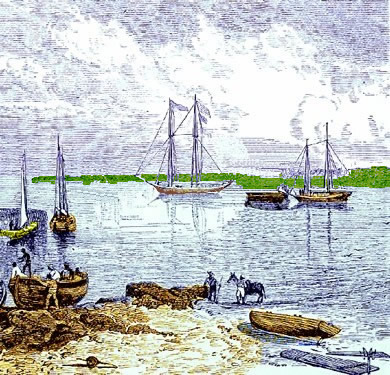
Nassau Harbor, Bahamas. From New York, Nassau and West India Mail
Steamship Line Promotional Material (1877)
Another account of a ship's crew getting provisions in the Bahamas comes from June 29, 1701 when a Portuguese slaver found herself "lost in the Gulf, and in great want of provisions."3 Captain Michael Cole explained that, upon learning of the ship, Bahamian Governor Elias Haskett "would not let any go aboard but his creatures, that he might ingross all the Trade to himself."4 Cole said Haskett would have purchased provisions from him for the sailors in need, but only at half the normal price. Cole wouldn't sell to him for that, so Haskett badgered Read Elding to provide the necessary foodstuff for one-third the price the Portuguese paid, the balance going to the governor.
Although he doesn't specifically talk about provisioning them, John Graves talked about how ships used Nassau Harbor in his account of the Bahamas where he was trying to make the case for nationalizing the Islands to the English government in 1708. He said it provided "the greatest Succour for all distress'd Ships that come thro’ the Gulph of Florida, and all others that are beaten off the Coast of New-York, New-England, and all the Nothern Shoar of America: I have known upward of Fourteen Sail in a Year come into Providence Harbour for Shelter."5 Such 'succour' would have included provisions in at least some of the cases.
Another example of a wrecked ship getting provisions in the Bahamas took place in May of 1715. Sloop captain George Herne was sailing somewhere in the Bahamas when he spotted a fourth rate Spanish man of war driven across a reef by stormy weather. "Capt. Herne sent his boat to offer assistance. The Spanish Captain declined it, believing them to be pirates, but afterwards purchased provisions from them etc."6
All of the remaining examples concern pirates, who were known to resort to the
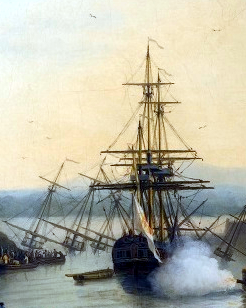
Artist: Dominic Serres the Elder
Ship in Ship Graveyard Firing, From The Capture of
Havana, The Morro Castle (1770)
Bahamas to provision their ships when going out to seek prey. The first comes from privateer Captain Matthew Musson when he was wrecked on Abaco in 1717. He explains that while he was on Harbor Island, he saw "severall pirates, which frequently are comeing and goeing to purchase provissons for the piratts vessells at Providence. There were there two ships of 90 tons which sold provissons to the said pirates, the sailors of which said they belong'd to Boston."7 He elsewhere noted that the pirates at New Providence included Benjamin Hornigold, Henry Jennings, Josiah Burgess, Daniel White and Edward Teach.
Once Rogers had taken control of New Providence, the Bahamas became more challenging for declared pirates to obtain provisions. In the fall of 1718, Charles Vane attacked Eleuthera which "he plundered the Inhabitants of as much of their Provision as they could carry away", sailing from there to Hispaniola, where he and his fellow pirates were "living riotously on board, having store of Liquor, and plenty of fresh Provisions, such as Hogs, Goats, Sheep, Fowl" which they had taken from Eleuthera.8 Vane also had sympathetic contacts on New Providence. Woodes Rogers reported in the fall of 1718 that when Benjamin Hornigold returned from a mission to spy on Vane, Hornigold captured Nicholas Hornigold in the Wolf, which Rogers had permitted "to go out a turtling but [who] had [actually] been trading wth. Vaine", bringing him ammunition and provisions.9
1 Calendar of State Papers Colonial (CSPC), Vol. 17, 1699, Item 294.i; 2 CSPC, Vol. 19, 1701, Item 655; 3,4 CSPC, Vol. 20, 1702, Item 120; 5 John Graves, A Memorial or a Short account of the Bahama-Islands, 1708, p. 4; 6 CSPC, Vol. 28, Aug, 1714 - Dec, 1715, Item 459.i; 7 Calendar of State Papers Colonial (CSPC), Vol. 29, 1716 - July, 1717, Item 635; 8 Daniel Defoe (Captain Charles Johnson), A General History of the Pyrates, Manuel Shonhorn, ed., 1999, p. 620; 9 CSPC, Vol. 29, Aug, 1717 - 1718, Item 635 & Defoe (Captain Charles Johnson), p. 145
Western Hemisphere Provisioning Locations: Bahamian Provisioning
The history of provisioning in the Bahamas was at least partially dictated by the earth found there, which was very different from the other Caribbean locations discussed. Unlike Jamaica and Barbados, the land in the Bahamas was not conducive for many of the plants Europeans would have liked to grow. Archeologist Heather Hatch explains, "
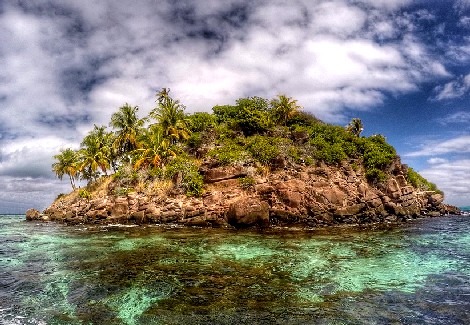
The Soil and Plants of Musha Cay, Bahamas
Geologically, the Bahamas have more in common with the uplifted limestone reef of Florida and the Keys than with the primarily volcanic islands of the Caribbean. This means that they were unsuitable for the large-scale plantation agriculture that developed in the Caribbean colonies."1 Indirectly supporting this, contemporary English naturalist Marc Catesby observed that all the good planting soil was "at the declivity of narrow valleys and low places, into which it is washed from the ascents above them, the corruption of vegetable matter, which lie in some places several inches deep, or a dark colour, light, and line grained. This soil is very productive the first two or three years ...but as the fertility of this land was soon exhausted, [it] obliged the proprietors to desist from cultivating it."2 He goes on to note that there is also red dirt, which is 'tolerably productive', white ground (probably sand) which was not very productive and rocks which could be broken up to allow planting of various root vegetables. The challenge of growing European crops helps explain why crop cultivation never occurred here on a large scale. Commenting on how past settlers had cultivated Harbor Island, engineer John Wilson said in 1783 that they didn't bother to clear land, instead "they went into the bush, dug holes with a stick between the trees, dropped in a few seeds and took no more care until they came back to harvest the crop."3
The first English settlers arriving in the Bahamas initially approached planting in the same way they had done on Barbados.
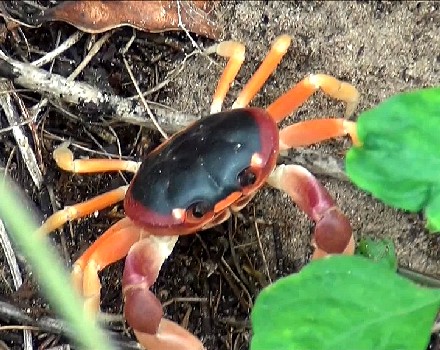
Photo: James St. John
A Black-Backed Land Crab Eating Plants on San Salvador Island, Bahamas
"First the land was cleared with fire and axe, and seed corn, peas, and pumpkins planted in the interspersed mode learned from the Indians of Virginia. Seed sprouted quickly... but most plants withered, those which survived the scorching sun and lack of water being eaten by land crabs and the rats that came in the ships."4 The limestone was nowhere near as accommodating to crops as the volcanic earth found in Barbados.5 With this failure, the nascent settlers had to learn to grow food in the same manner that the Lucayan natives had - by planting the seeds "in pockets and potholes... in shade. Soil was consolidated and conserved, fertilized with ash and bat earth [guano] from caves, and sometimes piled into mounds between standing trees, while the deeper holes, with perhaps two feet of fertile soil, were most valued of all."6 Such crops required rotation every three or four years due to depletion of the soil nutrients.
The stinginess of the islands thus contributed to the way they were used by their their new inhabitants. Rather than relying on planting them, the Bahamas' "main value was in the potential of their geographic position to take advantage, in many ways, of the trade passing up the Atlantic coast of North America. It was their context that made them valuable, and as such it is by understanding this context that the course of their development becomes clearer."7 The islands were never to become self-supporting throughout this period, depending on more plant-friendly islands near them and the American colonies for much of their food supply. Contemporary English historian John Oldmixon rather sourly commented, "Wrecks and Pyrates were the only Hope of [New] Providence, there being no Product to trade with except Brassiletto Wood and Salt."8
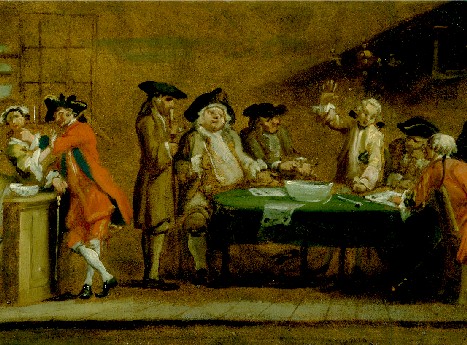
Artist: Joseph Highmore, att. - Figures in an Inn or Coffee House (ca 1725 - 1750)
Historians Michael Craton and Gail Saunders state that by 1684 the most interesting businesses in Charlestown (future Nassau), New Providence "were two or three inns - one of them significantly called the Wheel of Fortune - where the menfolk met and traded, and the visiting seamen 'refreshed' themselves. Most houses had their own sizeable yards or gardens, and there were a few further patches of cultivation just behind the ridge and on each side of town."9 The town already leaned towards the interests of wreckers, smugglers and pirates and these establishments were attractive to such customers.
In 1700, residents of the Bahamas sent a letter to the king requesting that the territory be purchased by England from the Lords Proprietors. Among the other reasons they give to justify this request, they state, "There are now merchants in Nassau who will victual 10 or 12 men of war."10 In the same batch of communication, Bahamian resident Thomas Walker suggested that "By good encouragement plantations of sugar, indico, cotton, provisions may be brought to perfection", further noting that "sundry families live now thereon [Harbor Island] with good store of oranges, limes and pleasant fruits at their doors."11 However, fruit would hardly have been of lasting use as ship's provision because it would not keep. It is interesting that these islands with so few resources for growing crops and maintaining cattle would claim to be a good choice for a naval victualling station. Walker's suggestion was never acted upon during this time.
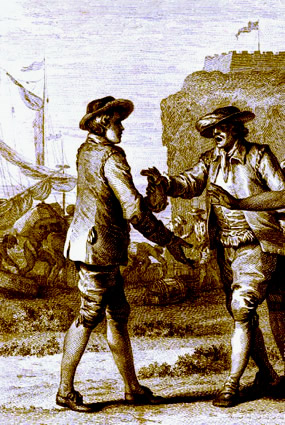
Artist: Jean-Michel Moreau
Un Anglais de la Barbade, vend sa Maitresse (1780)
In fact, little seems to have been done to cultivate the Bahamas. In May of 1700, Edward Randolph reported that, "That vast territory lies unimproved which, if under His Majesty's government, would bring in a vast revenue to the Crown. In my general discourse which I presented to the Board before I left England."12 He goes on to state that the settlers there wished to be freed from the government of the Lords Proprietors and that the leaders the Proprietors had chosen "go over worth little or nothing, [with the intent] to defraud His Majesty of his duty and the Proprietors of their perquisites and to enrich themselves by all unjust practices."13 He noted that such leaders discouraged the improvement of the islands. Randolph elsewhere states that some of the islands "are ...very large and capable of as great improvement as Barbados or Jamaica, 'Tis a mighty prejudice to trade, and a greater to the Crown that those noble persons and others to whom they do belong either do not or will not regard their own interest nor the well-being of the poor inhabitants"14.
Pirates received supplies and encouragement from some of the Bahamian residents during much of the English-run history of the Bahamas as the previous section on the history of the islands suggests. During the 'Flying Gang' pirates' takeover of New Providence, this illicit trade reached its apex. Thomas Walker, having moved to South Carolina to escape the pirates in the Bahamas, wrote in August of 1716 that the islands had become
a recepticall and shelter of pirates and loose fellows and gives ye inhabitants as well as ye trading vessuals from other parts ye liberty and opportunity of inriching themselves by sideing and dealing with, entertaining and releiveing such villians who from time to time resort there to sell and dispose of their piraticall goods, and perfusely spend wtt. they take from ye English, French and mostly Spaniards, and as I am an inhabitant of New Providence have bin an eye witness to those ellegiall and unwarrantable practises commited both by ye piratts and inhabitants and others tradeing there15
Captain Vincent Pearce, master of HMS Phoenix, who arrived in Nassau months before Rogers in 1718, commented, "Several times Summoned the Inhabitants together in His Ma[jes]ties name & us'd all the Arguments possible to prevail with them to assist me in Suppressing the said Pirate [Charles Vane], but they always Rejected all Methods
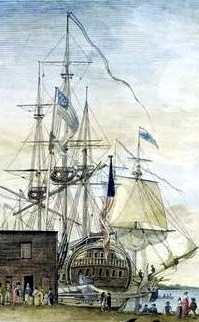
Artist: William Russel Birch
Ship in Port, The Library Company of
Philadelphia (1800)
Impos'd, entertain'd and assisted them [Vane's pirates] with provisions & necessarys & on all Occassions shew'd no small hatred to Government"16. Even Rogers' arrival didn't initially quell the provisioning of pirates by the Bahamians. In reviewing the progress made to disperse the pirates in the Caribbean, resident Christopher Gale wrote in the fall of 1718 that after Rogers had either pardoned or dispersed the pirates, "The next measures to be taken will be to prevent the trade with [the pirates by ships] from Rhoad Island, New York, Pensilvania, etc., for the pirates themselves have often told me that if they had not been supported by the traders from thence with ammunition and provisions according to their directions, they could never have become so formidable, nor arriv'd to that degree that they have etc."17
Rogers arrival in Nassau was intended in some ways to signal a conversion from piracy and wrecking to a more pastoral community. Perhaps his most telling comment about the potential for planting and growing crops there comes from a letter sent to the Council of Trade and Plantations in May of 1719. In it, he says that the Bahamian settlers
mortally hate it [working the land] for when they have clear'd a patch that will supply them with potatoes and yams and very little else fish being so plenty and either turtle or goanas [iguanas] on the neighbouring islands, they eat ym [them] instead of meat, and covet no stock of cattle but thus live poorly and indolently wth. a seeming content and pray for nothing but wrecks or the pirates, and few of them have an opinion of a regular orderly life under any sort of governmt. and would rather spend all they have at a punch house then pay me one tenth to save their familys and all yts. dear to them.18
Rogers noted that the Nassau Harbor was too shallow "for large ships but very fitt for small ones yt. [that] does not draw above 14 foot water and ther's few trading vessels in these parts draws so much so that ys. will be very convenient for trade and the other to receive the King's ships yt. shall come hither."19 Rogers' comment indicates that the Bahamas wouldn't serve as a supply base for the navy, other than for smaller vessels with shallow drafts. This is not surprising; with so many small islands and coral reefs, the residents relied on smaller vessels such as sloops to sail between the islands. In fact, it was the shallows around these islands which gave pirates their advantage over the much larger warships.
In December of 1719, two missives were written which mentioned provisioning in the Bahamas. The first appeared in a recap by one of Rogers' partners, merchant Samuel Buck. Buck noted (not surprisingly) that because
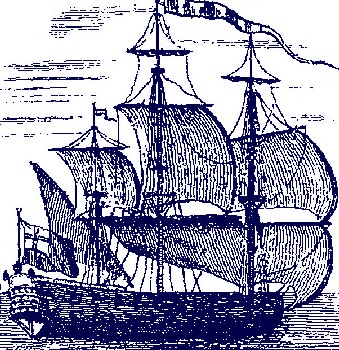
John Atkins' Ship, From A voyage to Guinea, Brasil, and the
West-Indies;
in His Majestys Ships, the Swallow and
Weymouth,
By John Atkins (1735)
Spain was at war with England, they refused to supply the Bahamas with cattle.20 The Bahamians had long carried on illicit trade with Spain, but this would have made procuring beef more challenging for them. Contrary to this, navy surgeon John Atkins wrote that when the HMS Weymouth was near the islands in the winter of 1723, the "Multitudes of little Islands and Kays... afford Refreshments of wild Hog, Cow, Goat, Sheep, Parrots, Guanas, Turtle, and Fish; many of them uninhabited and seldom visited"21. He even suggests that this was why so many pirates made the Bahamas their home.
The second letter of December, 1719 comes from the Council of Trade and Plantations who informed the Secretary of War that "another Independent Company with provisions and stores is absolutely necessary for the security and protection of those Islands, and that such allowance as H.M. shall think fit be made towards the great expence of the fortifications."22 No action was taken on this recommendation, however.
By January of 1720, the food situation was becoming desperate for the residents of New Providence. The governor and council sent a letter to the Council of Trade and Plantations complaining about the lack of support they had been given. "The credit of the King's garrison is quite extinct and unless there be some remedy to support it the necessitys daily encreasing we know not how the Governour can longer subsist them whilst provisions are brought here at a dear rate, and it being everywhere known that the Governour's bills are protested he cannot either purchase provisions or other necessarys."23 As had been the case all along, the Bahamas was not self-supporting; the war had likely increased the cost and danger of transporting supplies from the American colonies as well as other islands, so the price had gone up. Archeologist Heather Hatch notes, "Records from this period indicate that the colony's main trade partners were the Carolinas, a bare seven days sail away (ten on the return), where Bahamians exchanged tortoise shell and citrus fruits for provisions. Jamaica was another source of produce, exchanged for Bahamian salt and braziletto wood in seasons when local ships travelled to their western neighbour to hire themselves out in the carrying trade."24
A report received by English Secretary of State James Craggs the Younger 'from a person on whose intelligence I very much rely' in January suggested a different reason for the Bahamians difficulty in obtaining imported supplies.
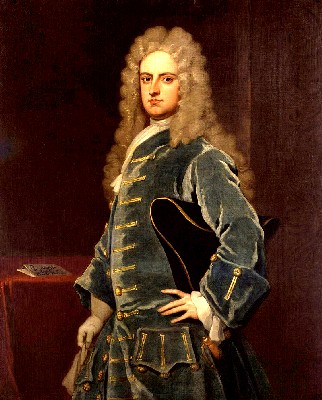
Artist: Sir Godfrey Kneller
James Craggs the Younger (c. 1708)
The settlement now consists of those who have lately been a pyrating mixt with strolers and old inhabitants who are but few of them better and all in a poor condition making little use of industry to cultivate the land etc. This discourages all manner of trade, their money which was chiefly got by pyrating or by dealing with them is spent and the place become so very poor, that tho' they want almost everything, vessels begin to carry back their cargoes, so that all manner of trade hither must shortly come to nothing.25
Craggs suggests that the Bahamian officials' letter was looking for a handout because they had not conserved their money or their land very well. Charles Carrington, a former member of the Bahamian Council, similarly (although less acridly) wrote in 1722 that the island residents were "a good-natur'd, friendly body of people, and seem only to have wanted countenance more than power or inclination, to have rais'd and preserved stock and cattle, and made better improvements in culture and trade. It is my firm belief, that good example, better usage and kind instruction, will make that Colony and people, all and whatsoever is desireable and comendable."26 However, it must also be remembered that the land did not lend itself to planting, except in certain small areas.
Not all the islands in the Bahamas seem to have been quite as indolent as those in New Providence, however. Buck reported, "The inhabitants of Eluthera and Harbour Island, being generally industrious, have plenty of all the necessarys of life, having great stores of Indian corn, yams, potatoes and cassada roots growing there etc."27
A couple people commented on the potential of the Bahamas for growing crops over the years. Richard Beresford of South Carolina observed in June of 1716 that "If the Inhabitants of Carolina and the Bahama Islands were more numerous and protected it is not doubted but that several other productions would thrive well in that climate as sentchanel, sugar, Fruit Coffee Olives Spanish vines Drugs and Cotton Wool & has been tryed & comes to perfection"28. While interesting, it is not clear from Beresford's letter who would be growing what. Fortunately, Bahamian governor George Phenney wrote a letter in December of 1723 which helps clarify this. "The greatest trade is to S. Carolina, bartering our fruit for provisions. Some of our vessels go to Jamaica to be there employ'd during the gathering of their crop of rum, and sugar carrying salt and braziletto, and bring back the produce of that Island."29 None of these things make for good food crops.
 An Exact Prospect of Charlestown, the Metropolis of the Province of South Carolina, From Gentleman's Magazine (1762) |
The idea that crops could be grown if cultivated persisted, however. Writing after the golden age of piracy in 1758, map-maker Jacques-Nicolas Bellin said that the soil on the islands was both excellent and fertile. He explained,
The English could make a much better use of the land, than they do today, and put themselves in a position to do without the help they get from Carolina, for the most necessary food supplies. It is all the more astonishing that they neglected this part, that their principal trade consists in the sale which they make of these same provisions to the vessels which come from the Isle of Cuba or from Santo Domingo, or that they carry themselves to these Isles, whose neighborhood facilitates them a very advantageous clandestine trade. We [the French] draw, however, from the Isle of Bahama, Corn & a little game; but that of Providence has so far supplied only Brasil wood and salt, which is selling very well in the Colonies of the Continent and in the Antilles.30
He later noted that the islands had a shallow draft, some potential products such as cotton grew naturally there but were not cultivated and the bays suitable for commerce were reasonably well foritied.31 Things had not changed much in the thirty years following the golden age of piracy.
1 Heather Hatch, Harbour Island - The Comparitive Archeology of a Maritime Community, 2013, p. 54; 2 Marc Catesby, The natural history of Carolina, Florida, and the Bahama Islands, Vol 2, 1754, p. xxxix; 3 Sandra Riley, Homeward Bound - A History of the Bahama Islands to 1850, 2015, p. 43; 4 Michael Craton and Gail Saunders, Islanders in the Stream, 1992, p. 81; 5 Hatch, p. 54; 6 Craton and Saunders,p. 81; 7 Hatch, p. 53; 8 John Oldmixon, The British Empire in America, 1708, p. 357-8; 9 Craton and Saunders,p. 98; 10 Calendar of State Papers Colonial (CSPC), Vol. 19, 1701, Item 1042.x (d); 11 CSPC, Vol. 19, Item 1042.ix(c); 12,13 CSPC, Vol. 18, 1700, Item 445; 14 CSPC, Vol. 18, Item 476; 15 CSPC, Vol. 29, 1716 - July, 1717, Item 328; 17 Admiralty Reocrds, PRO, 1/2282/13, 3 June, 1718; 17 CSPC, Vol. 31, 1719 - Feb, 1720, Item 31.i; 18 CSPC, Vol. 31, 1719 – Feb 1720, Item 209; 19 CSPC, Vol. 31, Item 28; 20 CSPC, Vol. 31, Item 473; 21 John Atkins, A Voyage to Guinea and Brazil, 1735, p. 225; 22 CSPC, Vol. 31, Item 474; 23 CSPC, Vol. 31, Item 523; 24 Heather Hatch, Harbour Island - The Comparitive Archeology of a Maritime Community, 2013, p. 70; 25 CSPC, Vol. 31, Item 525.i; 26 CSPC, Vol. 32, 1722 – 1723, Item 127 27 CSPC, Vol. 31, Item 555; 28 The Colonial Records of North Carolina, Vol 2, 1713-1728, William L Saunders, ed, 1886, p. 232; 29 CSPC, Vol. 33, 1722-23, Item 801.iii; 30 Jacques Nicolas Bellin, Description geographique des isles Antilles possédées par les anglois, 1758, p. 145-6; 31 Bellin, p. 148

